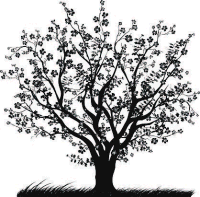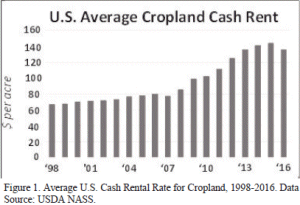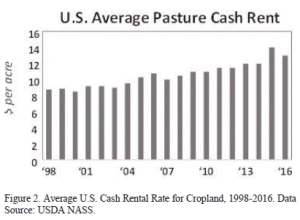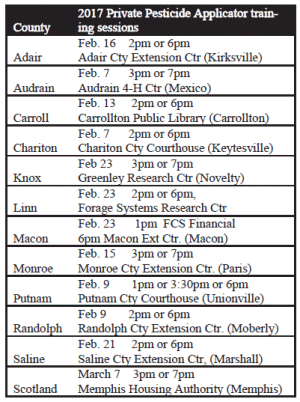

To send a message to an author, click on the author's name at the end of the article.
Correction:
In the January issue , 2016 Show-Me-Select Heifer Sale article, the printed averages from the other sales were incorrect. The correct averages are below:
Averages of other Show-Me-Select sales from fall 2016 were Farmington, $1,518 on 117 head; Joplin, $1,651 on 364 head; Kirksville, $1,731 on 149 head; Kingsville, $1,910 on 148 head; and Fruitland, $1,962 on 96 head.
This Month in Ag Connection | Ag Connection - Other Issues Online
Economic situations have caused several farmers to re-evaluate production systems that maximize yield and maintain environmental sustainability. Agricultural drainage is not a new concept; however, utilizing drainage as part of an integrated water management system is a relatively new concept shown to improve water quality and sustain agricultural viability.
Upland, flat claypan soils commonly have a seasonal perched water table from November to May, which is caused by an impermeable underlying clay layer restricting internal drainage. Research in other states has reported increased crop production using an agricultural drainage system incorporating subsurface drainage and subirrigation. The MUDS (MU DRAINAGE AND SUBIRRIGATION) research program was initiated at the University of Missouri Greenley Research Center near Novelty in 2001 to determine the suitability of claypan soils for drainage and drainage plus subirrigation.
A summary of the research through 2015 showed the combination of drainage and subirrigation increased corn yields by 45 percent and soybean yields by 20 percent in claypan soils. The MUDS system installed at the Greenley Research Center site allows excess water to drain and be retained as needed.
The research also has shown how proper drainage protects the environment and cuts input costs. The drainage water management system reduced nitrate loss by 70 percent and phosphorus loss by 80 percent.
The drainage water management system utilizes a water control structure as its key component. The water control structure has slides, or gates, which allow adjustment of the water table in the soil. Water is sped up for drainage or slowed for irrigation, based on soil needs.
The structures are spaced through water management zones based on the field's slope. Water either flows or is retained based on precipitation and the growth stage of the plant. Computer models have shown the optimal distance between drainage tiles was 20 feet. Researchers found that wider spacing (30 and 40 feet), while less expensive, was ineffective in claypan soils.
The drainage water management system may not be cost-effective or necessary for all sites as the benefits should be greater than the cost. It should be noted if the system is not designed and installed properly reduced yields may result.
One major advantage to the drainage system is properly drained fields can be planted 10-14 days earlier, often leading to increased yields. MU research shows undrained, saturated fields affect crop health even after a single rainfall event. Excess water flow also leads to soil compaction.
The Greenley Research Center plans to upgrade its system in 2017. A large-scale drainage water management system will be installed in cooperation with the Missouri Land Improvement Contractors of America and USDA's Natural Resources Conservation Service at the center's 240-acre Grace Greenley Farm. It should be noted a field day will occur on August 8, 2017 highlighting the new drainage system.
Kelly Nelson, lead researcher on the MU drainage project, is co-author of the Purdue University Extension publication "Drainage Water Management for the Midwest," available for free download at extension.purdue.edu/extmedia/wq/wq-44.pdf.
For more information on drainage research in Missouri, go to greenley.cafnr.org/muds.
Source: Kent Shannon, Natural Resource Engineer
This Month in Ag Connection | Ag Connection - Other Issues Online
In northern and central Missouri, mid to late February is the ideal time to prune fruit trees and small fruit plants like grapevines and bramble fruits. Pruning at this time allows for quicker healing of wounds created during the pruning process. Fruit trees and small fruit plants must be pruned annually to maintain good plant health and uniform fruit loads from year to year. Prune before bud break, and selectively prune out winter damaged fruiting wood and broken and diseased branches.

From determining tree form to influencing crop load and crop quality, pruning has many direct effects on what a fruit tree can deliver over the short and long term. One of the goals of annual pruning is to maintain appropriate height and spread of a fruit tree, and to ensure adequate presence of fruiting wood. It is important to understand that most of the energy a fruit tree develops throughout the season will find its way into either this year's fruit or next year's flower buds. This emphasizes the importance of balancing these types of growth. The goal is to get plenty of fruit this year without sacrificing next year's potential. Finding a balance between vegetative and reproductive growth can be difficult at first, especially if fruit trees have not been pruned for a number of years.
If renovating an old, abandoned tree, striking this balance may take a few years because it is not recommended to remove more than 1/3 of a fruit tree's growth in a single year. The ultimate goal is to avoid alternate cropping years where an abundant harvest is experienced every other year with little-to-no fruit in the off years.
A well-maintained tree that receives an appropriate annual pruning will be much easier to maintain than one that does not. This practice, along with good fertility management, pest control, and fruit thinning (where appropriate) will help ensure an optimal level of productivity.
2017 All-America Selections
All-America Selections (AAS) is a non-profit trialing organization for plants that demonstrate great garden performance throughout North America. AAS presents sixteen exciting new Winners for the 2017 garden season. Each of the following varieties was trialed in North America by professional, independent, volunteer judges during one growing season. Each was trialed next to comparison varieties that are considered best-in-class among those currently on the market. The group of AAS Winners for 2017 includes:
Vegetables
Flowers
These are all annual plants that can be planted in Missouri. Gardeners should be able to find these AAS Winners for sale for the 2017 gardening season as supply becomes available throughout the chain of distribution. For further information on AAS Winners, go to all-americaselections.org
Source: Jennifer Schutter, Horticulture Specialist
This Month in Ag Connection | Ag Connection - Other Issues Online
In August of 2016, USDA released its annual update on farmland market conditions. The U.S. average cash rental rate for cropland is shown in figure 1. Since 2008, rental rates have increased until 2016 when they fell 6%, to $136 per acre. The only other decline in national cropland cash rental rates since 1998 was a 3% decline in 2007.

So how did state and county rates compare? According to USDA NASS (National Agriculture Statistics Service), changes in the state average for 2015 cropland rental rates compared to 2016 showed varied rates. For the Midwest, cash rents dropped more than 6% in Minnesota and Iowa, while most of the Midwest, Great Plains, Southeast, and West were also lower. In, Michigan and Wisconsin higher cash rental rates were reported.
On the county level, rental values fell the most in Minnesota, Iowa, Northern Missouri, and Northern Illinois. Since USDA did not collect county based figures for 2015, the change is reflected from 2014. Pasture rental rates dropped by 7% nationally (Figure 2) with much variability across states. Missouri averaged a 6% decrease in pasture rental rates. Nebraska showed a drop of 16% and South Dakota, an 11% drop. Pasture rental rates in Oklahoma (+12.5%), Arkansas (+11%), and Florida (+15%)were sharply higher in 2016.

Some factors affecting pasture rental rates include quality and quantity of water, quality of fence, forage species, facilities, and proximity of land to renter's residence.
As prices of commodities drop and farm income follows, input costs and management become the difference between surviving the agriculture downturn or exiting the industry. Tenants and landowners should openly and honestly communicate about these issues. Consider alternatives to cash leases including share and flexible lease arrangements. Return on investment, though very important, should be balanced with care of the land, trespass control, neighborly relations, and other points of value such as brush cutting the property or roadsides. Contact your local University of Missouri Extension agricultural business specialist to assist in determining a fair lease agreement. .
Source: Darla Campbell, Ag Business Specialist
This Month in Ag Connection | Ag Connection - Other Issues Online

Farmers and landowners are required to have a Private Pesticide Applicator license in order to purchase, apply, or supervise the application of restricted use pesticides for the purpose of producing any agricultural commodity. Individuals needing to obtain or renew Private Pesticide Applicator Certification to purchase restricted use pesticides may do so by attending one training session. In order to obtain certification each farm must possess the official Private Pesticide Applicator Reference Manual, available at each training session for $12 (cash or check). Individuals already in possession of the reference manual may bring it to a training session to avoid having to purchase a new manual.
Private Pesticide Applicator certification is valid for 5 years, at which time the individual may renew their certification by attending another Private Pesticide Applicator training session. Individuals unable to attend a training session may contact their University of Missouri Extension County office to schedule time to watch a three hour training video and purchase the training manual to receive certification.
Individuals with a license expiring in 2017 should have received a reminder postcard from the Missouri Department of Agriculture. Individuals needing a first time certification, as well as individuals needing to renew an expired certification can do so at a training session or by watching the training video. For more information contact your University of Missouri Extension County office using the contact list on the front page of this newsletter or go online to extension.missouri.edu.
Source: Max Glover, Agronomy Specialist
Publishing Information
Ag Connection is published monthly for Northeast and Central areas of Missouri producers and is supported by the University of Missouri Extension, the Missouri Agricultural Experiment Station, and the MU College of Agriculture, Food and Natural Resources. Managing Editor: Mary Sobba.